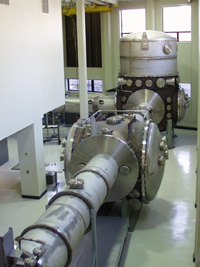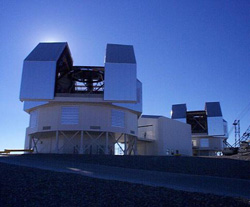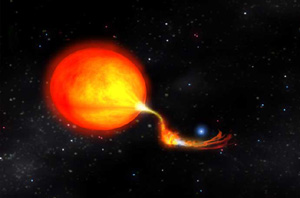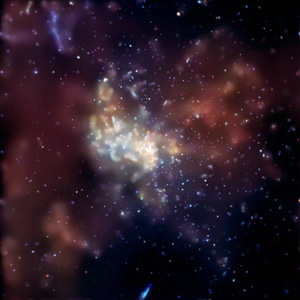Center for Space Research
The Center for Space Research (CSR) conducts research in astronomy, astrophysics, space science, detector engineering, and related technology and participates in various National Aeronautical and Space Administration (NASA) flight missions. Specific areas of research include extragalactic astronomy and cosmology, galactic astronomy, the solar system and space plasma physics, and the space life sciences. Research conducted in CSR is reported by the Departments of Physics, Earth, Atmospheric, and Planetary Sciences, Aeronautics and Astronautics, and Chemical Engineering and by the Harvard-MIT Division of Health Sciences and Technology. CSR is the home of the Astrophysics Division of the Physics Department, supporting faculty, postdocs, and students. Students actively participate in research; in the past year, 39 graduate students and 25 undergraduate students from four departments worked on CSR projects.
 The LIGO Advanced System Test Interferometer is a unique installation at MIT for the test of full-scale systems to be installed in the gravitational-wave observatories. It is currently being used to develop a seismic isolation solution for the Livingston LIGO interferometer and will then move on to tests of the advanced LIGO optical and mechanical systems. Photo courtesy of MIT/D. H. Shoemaker. |
CSR supports MIT involvement in three major observatories: the Magellan Observatory (Professor Schechter, MIT director), the Laser Interferometric Gravitational-wave Observatory (LIGO; Dr. Shoemaker, MIT director), and the Chandra X-Ray Observatory (CXO; Professor Canizares, associate director). The Magellan consortium operates two 6.5-meter optical telescopes in Chile. The first and second telescopes began routine science operations in February 2001 and September 2002, respectively. The LIGO Laboratory, a collaboration of Caltech and MIT, is engaged in developing and commissioning gravitational-wave telescopes. The Washington and Louisiana observatories made significant strides toward their target sensitivity this year and collected their first scientific data in two science runs. The Chandra satellite was launched as a major NASA mission in 1999 and continues to be extremely productive. Two of the four Chandra scientific instruments were built at CSR: the High-Energy Transmission Grating (HETG) Spectrometer and the Advanced Charge-Coupled Device (CCD) Imaging Spectrometer. CSR is also active in the Chandra X-Ray Observatory Science Center (CXC).
 The two Magellan telescopes, located on the Cerro Manqui peak at Las Campanas Observatory in Chile. Photo courtesy of the Observatories of the Carnegie Institute of Washington. |
In addition to the major observatories, CSR is involved in several more focused space missions. The Rossi X-ray Timing Explorer (RXTE; Dr. Levine, principal investigator) has entered its eighth year of successful operation. CSR's All-Sky Monitor instrument continuously surveys the sky for new sources and finds interesting targets for other observatories. The High-Energy Transient Experiment 2 (HETE-2) mission (Dr. Ricker, principal investigator), built and operated at MIT with US and international collaborators, was launched in 2000 and is dedicated to the detection and prompt localization of the sources of gamma-ray bursts. Detectors for the Astro-E2 X-ray spectroscopy mission (Dr. Bautz, principal investigator) have been built and calibrated. Astro-E2 is to be launched by the Japanese Institute of Space and Astronautical Science in early 2005.
Research in CSR's Space Nanotechnology Laboratory (Dr. Schattenburg, director) seeks to apply micro- and nanofabrication technology to achieve dramatic improvements in lightweight, high-resolution optical components including foil-optic mirrors and diffraction gratings. Development work for future large X-ray telescopes is in progress.
Research Highlights
Extragalactic Astronomy and Cosmology
A new look at the striking jets emitted by active galactic nuclei has been provided by the Chandra X-ray Observatory. The X-ray data combined with radio data have been used to determine the velocities of outflows in the jets associated with active galactic nuclei, providing strong evidence that the outflows are indeed relativistic. These studies have provided the best measurements of the magnetic fields believed to confine the flow. New analysis methods applied to Chandra data have also constrained the dark matter distributions and state of the intracluster medium in galaxy clusters. A HETE-2 highlight was the localization of one of the brightest gamma-ray bursts (GRBs) ever detected to date. Follow-up observations worldwide confirmed the suspected connection between GRBs and supernovae. As LIGO begins operation, the first science results have established upper limits on gravitational wave sources of various kinds; more sensitive observing runs are planned in the near future. In theoretical studies, a new approach to the buildup of dark matter halos around galaxies has been developed. Numerical general relativistic calculations are being carried out to predict the properties of gravitational wave signals expected from compact stars captured by supermassive black holes. These calculations are guiding the design of NASA's Laser Interferometer Space Antenna, a planned gravity-wave observatory in space.
Galactic Astronomy
 A pulsar in a binary system accretes material from its companion star. This influx of material can eventually spin up the pulsar to the millisecond range. From the distribution of spin periods in pulsars, Professor Chakrabarty and his group deduce that there is a maximum rotation rate, possibly due to a loss of energy through gravitational radiation. Such radiation may be detectable with the LIGO. Illustration courtesy of Dana Berry/NASA Goddard Space Flight Center. |
RXTE and Chandra investigations into the nature of black holes, neutron stars, and related objects continue. Studies of fast oscillations from millisecond X-ray pulsars, both in and out of the stellar thermonuclear explosions known as X-ray bursts, provide insight into the physics of neutron stars. In one highlight this year, data on the distribution of spin rates in neutron stars provide evidence that such stars may be strong emitters of gravitational radiation. This has important implications for search strategies on gravitational wave detectors. Studies of binary star systems containing white dwarfs, neutron stars, and black holes are being carried out in an effort to model cataclysmic variables, low-mass X-ray binaries, binary radio pulsars, and black hole transients. New binary evolution scenarios involving large transfers of angular momentum have been identified. These appear particularly promising for generating hypernovae, explosive events thought to be the origin of many cosmic gamma-ray bursts.
 Chandra image of the supermassive black hole at the center of our galaxy. The observation was made by an international team led by Dr. Fred Baganoff of the MIT Center for Space Research using the Chandra Advanced CCD Imaging Spectrometer built at MIT under the direction of Dr. George Ricker, in collaboration with Pennsylvania State University. Photo courtesy of NASA/CXC/MIT/F. K.Baganoff et al. |
In Chandra studies of the Milky Way, thousands of new galactic X-ray sources have been discovered, and an X-ray jet and daily X-ray flares have been detected from the supermassive black hole believed to reside at the center of our galaxy. High-resolution spectra obtained with the HETG have been used to probe the relativistic outflow from galactic microquasars and to study spectral features in X-ray binaries, plasma accretion processes, atmospheres of neutron stars, stellar coronae and winds, supernovae, and young supernova remnants. With these techniques, the dynamics and composition of supernova remnants are being mapped in exquisite detail.
The Solar System and Space Plasma Physics
In recent years, Mars has been the subject of intensive study by several instruments aboard the Mars Global Surveyor spacecraft, investigating the atmospheric conditions under which carbon dioxide and water ice clouds form and precipitate in Martian polar regions. X-ray studies of Jupiter and its moons have resulted in the first detection of X-rays from the moons Io and Europa and the first X-ray spectroscopy of individual regions within the Jovian auroral zones. Studies of plasma in the solar wind continue from three spacecraft: IMP 8 and Wind, Near Earth, and Voyager 2, the last currently at a distance of 70 astronomical units from earth. These studies have demonstrated for the first time the presence of marginal instability limits associated with plasma wave modes, provided an estimate of the density of interstellar hydrogen, and shown a source of hydroxyl at Saturn near Enceladus. A high-time-resolution solar wind experiment on the Triana spacecraft is expected to be launched within two years. An innovative theory of complexity in space plasmas in the Earth's magnetosphere, the solar corona, and the solar wind has been developed using the concepts of forced and/or self-organized criticality and topological phase transitions.
Human Space Flight
CSR is developing virtual reality display devices, restraint systems, and software tools for the International Space Station (ISS) Human Research Facility. The system supports Visuomotor and Orientation Investigations in Long Duration Astronauts, a set of flight experiments planned for 2004–2005. Other experiments being developed for the ISS include the Cell Culture Unit for biological experiments and an astronaut microgravity disturbance experiment. Ground-based efforts include studies of human responses to intermittent artificial gravity and the application of virtual reality techniques to preflight training of astronauts.
Instrumentation for the Future
Looking toward future missions, high-performance X-ray sensors are being developed in collaboration with MIT's Lincoln Laboratory. Galactic emission mapping detectors are being adapted for use in space in collaboration with MIT's Laboratory for Nuclear Science. Work continues in the Space Nanotechnology Laboratory on advanced X-ray optics with applications targeted to future missions such as Constellation X, Generation X, and the MicroArcsecond X-ray Imaging Mission. An adaptive optics system for the Magellan telescopes is under development. With Haystack Observatory, work continues on the development of a large low-frequency radio array, which will also serve as a prototype for the future Square Kilometer Array. The Advanced LIGO proposal for a second generation of gravitational detectors to be installed in the LIGO infrastructure has been submitted to the National Science Foundation. A new research path to explore and extend the quantum limits to gravitational-wave detectors has been established in the MIT LIGO group, with applications to Advanced LIGO and later detectors.
Education and Public Outreach
Education and Public Outreach (Dr. Flanagan, director) activities foster the direct participation of CSR scientists in educational initiatives, with one-third of the research staff directly involved. Formal education programs reached hundreds of K–12 students, about half from underrepresented groups. Among the most successful initiatives was the Chandra-Science after School Pilot, which culminated in two weeks of full immersion in space science for high school students from Boston public schools.
More information about the Center for Space Research can be found on the web at http://space.mit.edu/ .